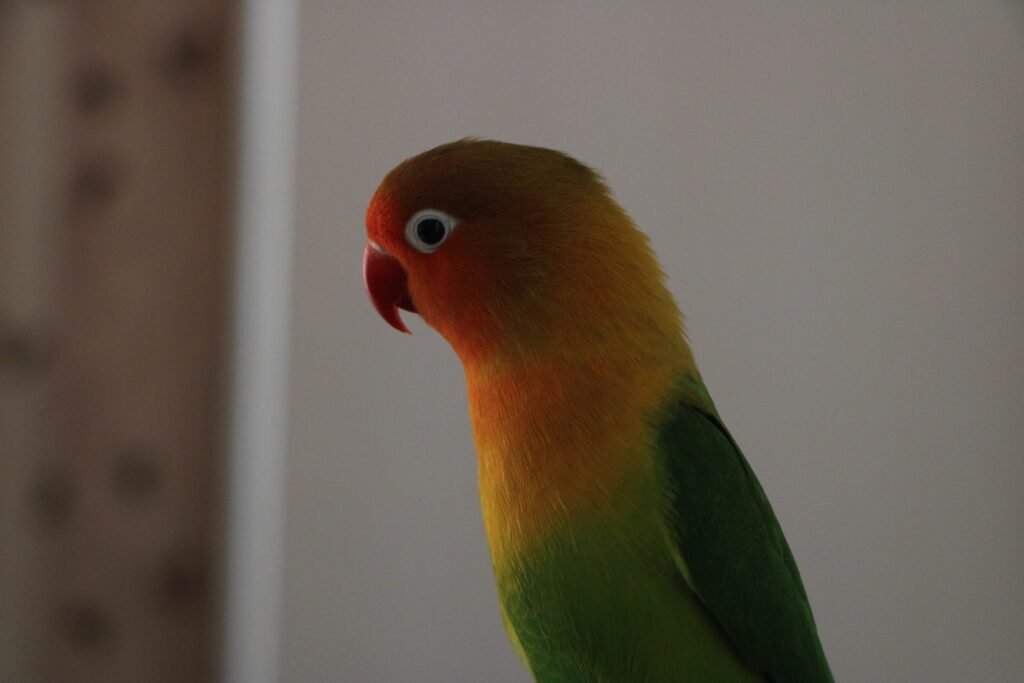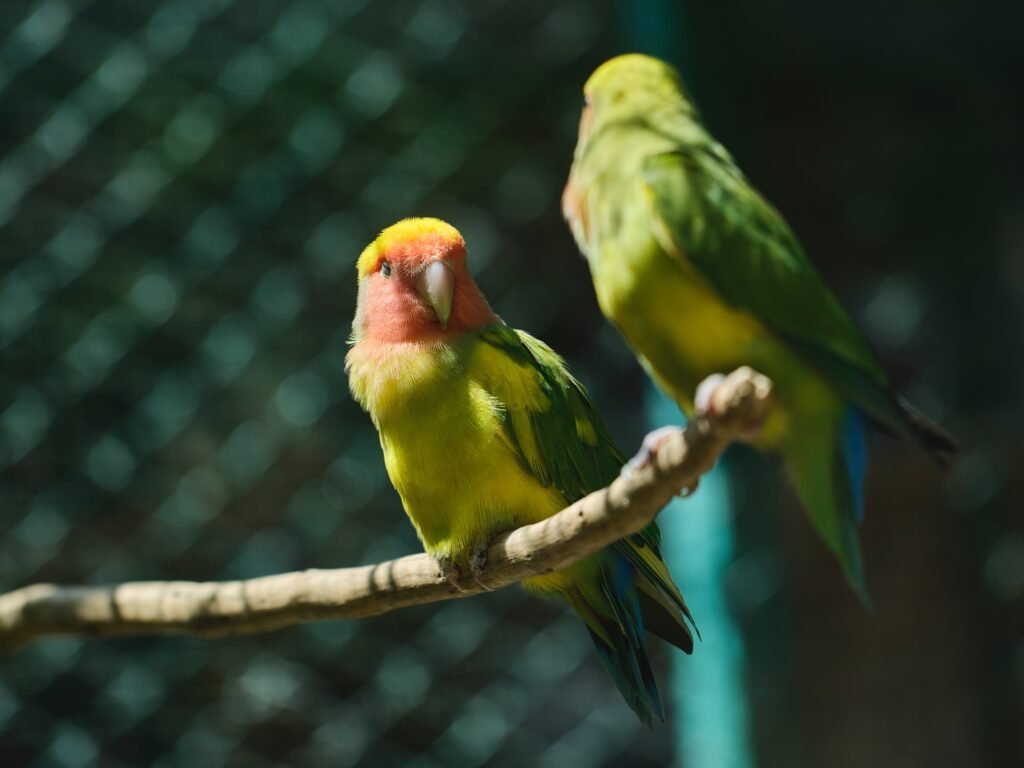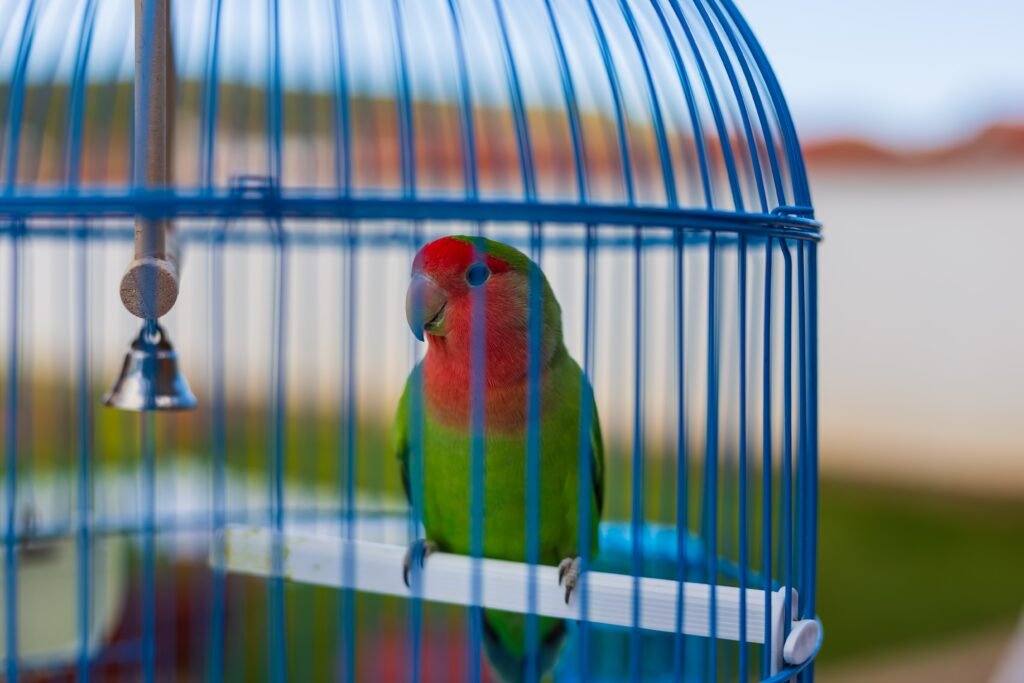
Physical Characteristics
1. Size and Body Structure
Male and female lovebirds often differ in size and overall body structure. In general, male lovebirds tend to be slightly larger and may have a more robust build compared to their female counterparts. However, it is important to note that size differences alone are not always reliable indicators of gender, as individual variation can occur within the same species.
When observing the size and body structure of lovebirds, it is essential to compare individuals of the same species. For example, in the Fischer’s lovebird species, males are typically around 6 inches in length, while females are slightly smaller, measuring around 5.5 inches. Similarly, in the Peach-faced lovebird species, males can reach up to 6.3 inches, while females are usually around 5.9 inches. These variations can help you identify the gender of your lovebird more accurately.
2. Plumage Coloration and Patterns
Plumage coloration and patterns play a vital role in determining the gender of lovebirds. The specific colors and patterns vary depending on the species, but certain characteristics can help you identify the sex of your bird.
- Differences in Color: In some lovebird species, males showcase more vibrant and intense coloring compared to females. They often exhibit bold and bright hues, while females may display slightly duller shades. For example, in the Masked lovebird species, males have a vibrant green body with a black mask, while females have a more muted green coloration without the prominent mask.
- Head Markings: Male lovebirds typically possess distinct head markings, such as a vibrant mask or a pronounced coloration around the eyes. This is especially evident in species like the Fischer’s lovebird, where males have a bright orange face and forehead, while females have a lighter and less vibrant coloration.
- Tail Feathers: Examining the tail feathers can also provide valuable information about the gender of your lovebird. In some species, males have longer and more pointed tail feathers, while females may have shorter and rounder ones. This is particularly noticeable in species like the Nyasa lovebird, where males have long, pointed tail feathers, and females have shorter, rounded ones.
Remember that plumage coloration alone may not always guarantee accurate identification, as certain color mutations or hybridization can affect the typical gender-specific characteristics. It is important to consider multiple physical traits when determining the gender of your lovebird.
Behavioral Differences
Apart from physical characteristics, observing the behavior of lovebirds can also help you determine their gender. While these behavioral traits are not foolproof methods, they can provide additional clues about the sex of your bird.
1. Courtship Displays
Lovebirds engage in courtship displays as a way to communicate their sexual interest. Males often exhibit more extravagant and elaborate displays to attract a mate. They might puff up their feathers, bob their heads, and perform lively dances to impress the female. These courtship displays are typically more pronounced in male lovebirds.
On the other hand, females tend to have a more passive role during courtship. They may show subtle signs of interest, such as preening or feeding the male, but their behaviors are generally less flamboyant compared to males. Observing courtship displays can give you insights into the gender of your lovebird.
2. Nesting Behavior
Observing nesting behavior can be another useful method to identify the sex of your lovebird. Females typically show more interest and involvement in building the nest, while males usually focus on protecting the nesting territory. Females may gather nesting materials, such as twigs and leaves, and actively arrange them in the nest. Males, on the other hand, may spend more time guarding the nest and displaying territorial behaviors.
However, it is important to note that not all lovebirds exhibit strong nesting instincts, and the absence of this behavior does not necessarily indicate the sex of the bird. Some lovebirds may not show significant nesting behavior, especially if they are young or not in a breeding phase. Therefore, it is crucial to consider nesting behavior along with other physical and behavioral characteristics when determining the gender of your lovebird.
3. Vocalization
While both male and female lovebirds are capable of vocalizing, their vocal patterns and repertoire can differ. Males often have a wider range of vocalizations, including various chirps, whistles, and even mimicking sounds. They may use vocalizations as a way to communicate with their mate or establish dominance within their territory.
Females, on the other hand, tend to have a more limited vocal range and may primarily communicate through soft chirping. They may use vocalizations to express contentment, attract their mate’s attention, or communicate with other lovebirds in their flock.
Observing the vocalizations of your lovebird can provide valuable insights into its gender. However, it is important to note that vocalization alone may not be sufficient to determine the gender accurately. Combining vocal patterns with other physical and behavioral traits can help you make a more informed judgment.
DNA Testing
If you still find it challenging to determine the gender of your lovebird based on physical characteristics and behavior, DNA testing can provide a reliable and accurate solution. DNA testing involves collecting a small blood sample or plucked feathers and sending it to a laboratory specializing in avian genetics. This method can determine the bird’s sex by analyzing its DNA.
DNA testing is particularly useful for visually identical species or birds with atypical plumage coloration due to mutations. It eliminates any guesswork and provides a definitive answer regarding the gender of your lovebird. This method is highly accurate and commonly used by breeders and avian enthusiasts to ensure the correct identification of lovebirds.
Conclusion
Determining the gender of lovebirds can be an exciting and informative process. By closely observing physical characteristics such as size, plumage coloration, and patterns, as well as considering behavioral traits such as courtship displays, nesting behavior, and vocalization, you can make an educated guess about your lovebird’s gender. However, for a definitive and accurate identification, DNA testing remains the most reliable method. Understanding the gender of your lovebird not only helps you care for them better but also allows you to appreciate their unique qualities as individuals.
FAQ
Q: How can I determine the gender of my lovebird based on physical characteristics?
A: You can determine the gender of your lovebird by observing size and body structure, as well as plumage coloration and patterns. Male lovebirds are generally slightly larger and may have a more robust build. Males also often showcase more vibrant and intense coloring compared to females, and they may possess distinct head markings and longer, more pointed tail feathers.
Q: What are some behavioral differences that can help me determine the gender of my lovebird?
A: Observing courtship displays and nesting behavior can provide clues about the gender of your lovebird. Males often engage in extravagant displays to attract a mate, while females have a more passive role during courtship. Females typically show more interest and involvement in building the nest, while males focus on protecting the nesting territory. Additionally, vocalization patterns can differ between males and females, with males having a wider range of vocalizations.
Q: Can vocalization alone determine the gender of my lovebird?
A: While vocalization can provide insights into the gender of your lovebird, it is not sufficient on its own. Males often have a wider range of vocalizations, but combining vocal patterns with other physical and behavioral traits is necessary for a more accurate determination of gender.
Q: What is the most reliable method to determine the gender of my lovebird?
A: DNA testing is the most reliable and accurate method to determine the gender of your lovebird. This involves collecting a small blood sample or plucked feathers and sending it to a laboratory specializing in avian genetics. DNA testing eliminates any guesswork and provides a definitive answer regarding the gender of your lovebird.


